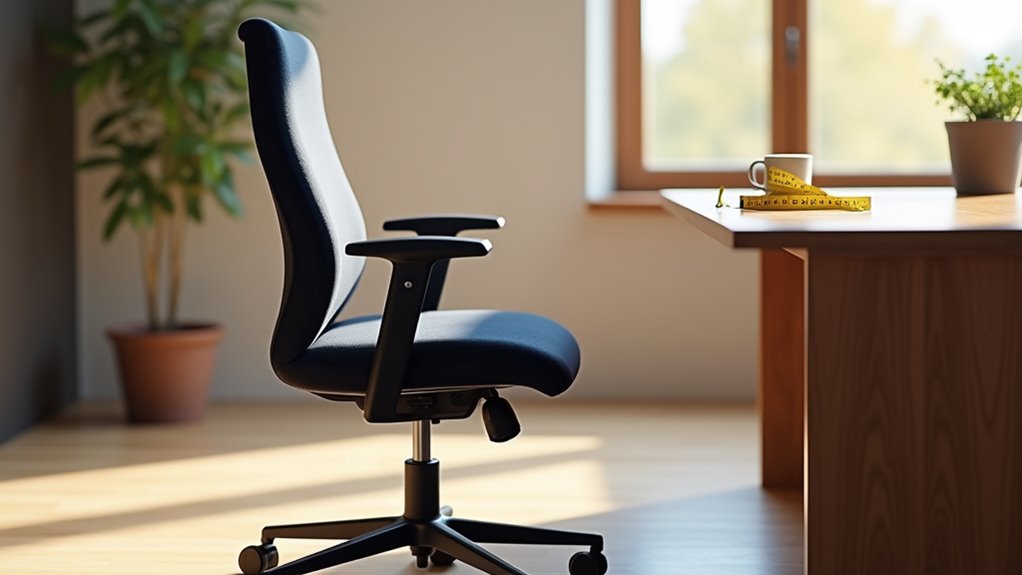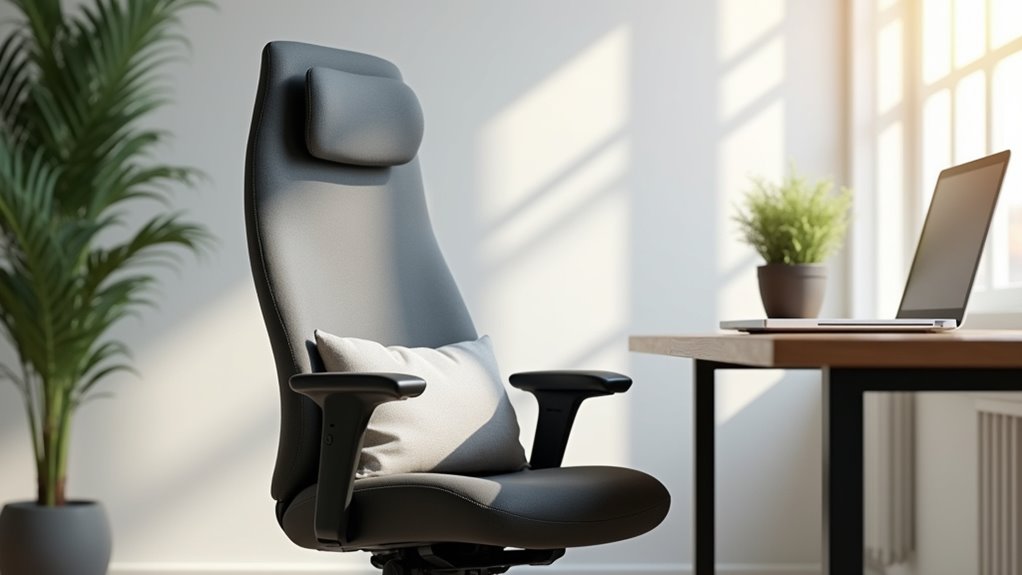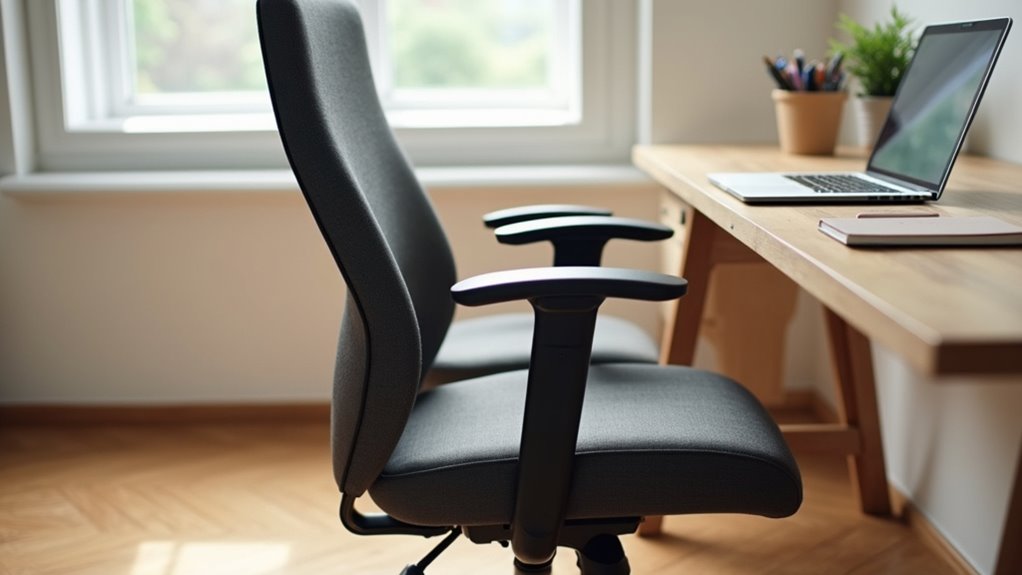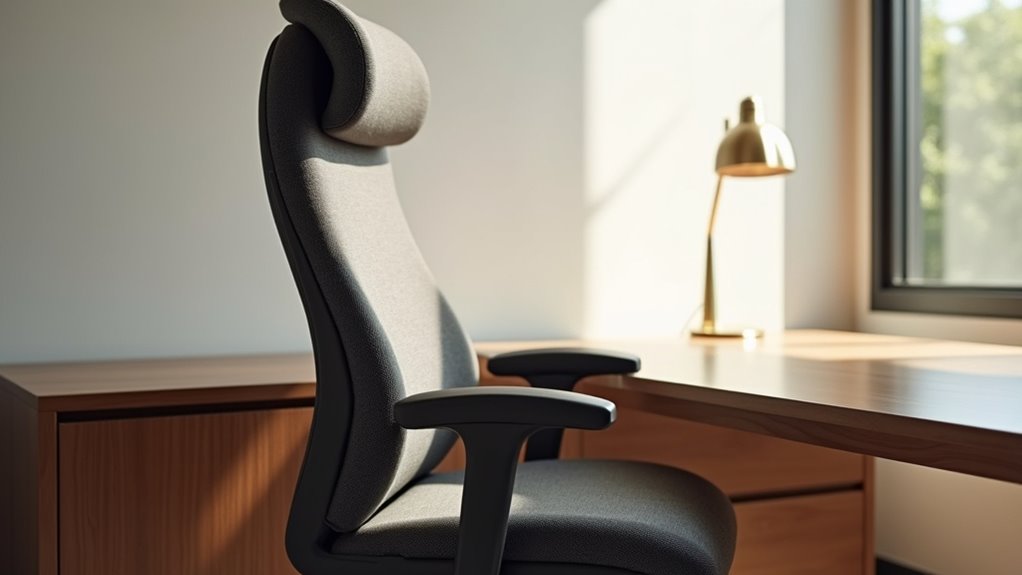How to Sit Properly on a Chair
This post contains affiliate links. As an Amazon Associate, we earn from qualifying purchases.
To sit properly on a chair, adjust the height so your feet are flat on the floor and your knees form a right angle. Maintain a gap of 2-4 inches between the seat and the back of your knees for comfort. Your back should align with lumbar support, and your arms should rest at a 90-degree angle. Keep your chin parallel to the floor. For those interested in more detailed tips and explanations, further information will be provided later in the article.
Essential Facts in 30 Seconds
- Adjust seat height for flat feet and right angle at knees.
- Align chair for proper lumbar support around L3-L5 area.
- Keep upper arms close with elbows at 90° to 110° angle.
- Position monitor an arm’s length away, with head neutral.
- Take regular breaks to move and stretch for good posture.
Adjusting Seat Height and Leg Position
Getting your seat height just right is crucial for comfort and support. For people who are 5’7″ to 5’10”, a seat height of 17″ to 19″ works best. Taller folks between 6’3″ and 6’6″ should choose a height of 19″ to 21″. For shorter individuals, around 4’11” to 5’2″, a lower seat height of 14″ to 16″ is ideal. Ergonomically designed chairs aim to ensure that knees are bent at a 90-degree angle and feet are flat on the floor. Adjusting the chair height correctly impacts overall comfort significantly. Additionally, maintaining a proper sitting posture while seated is essential for reducing discomfort.
Sit down and check your leg position. Your legs should bend at a right angle, and your feet need to rest flat on the floor—no dangling feet! This ensures that you can maintain proper posture while seated. Measure from the floor under your heel to the bottom of your kneecap. This helps find the right height. If your feet don’t reach the ground, use a footrest.
Keeping your legs comfortable helps you work better. Adjust your seat to sit like a pro!
Ensuring Proper Seat Depth and Thigh Support

Getting the right seat depth is key for comfort. Aim for a gap of two to four inches between the seat and the back of your knees. This helps with blood flow and keeps you comfy. A well-designed chair with adjustable seat depth can greatly enhance your comfort and support throughout the day. Proper seating can reduce the risk of discomfort and promote better focus during your tasks. Additionally, proper chair height adjustment is crucial for maintaining a healthy posture while seated.
A good chair supports your thighs well. This support keeps you focused and stops fidgeting. Stay comfortable as you work on your tasks!
Optimal Seat Depth
Finding the right seat depth is key for comfort. Think of it as a gentle hug for your thighs. Aim for two to three fingers’ width between the seat edge and the back of your knees. This space helps with comfort and keeps your blood flowing. No more “knee-ninja” moments! Proper chair height adjustment is also crucial for ensuring that your thighs remain parallel to the ground and your knees create a 90-degree angle.
To measure your perfect fit, sit down and check the distance from your hips to behind your knees. If you have an ergonomic chair, adjust the seat depth until it feels just right. Proper seat depth affects overall sitting comfort and posture. Seat depth adjustment can significantly enhance your sitting experience, especially during prolonged periods. Slide it forward or backward as needed. Good posture begins with a comfy seat. Stay comfortable and feel great as you sit!
Thigh Support Importance
Finding the right seat depth is just the start. Thigh support matters for comfort and health. Good support helps reduce muscle fatigue. It spreads your weight evenly. This also relaxes your hip flexors and keeps your pelvis aligned. Proper chair height adjustment is crucial for achieving optimal ergonomics. Additionally, proper alignment of your thighs can help promote good circulation throughout the legs.
Try adjusting your chair height. A cushion can help too. This way, you maintain a good pelvic tilt. A straight back reduces strain. You can sit longer without feeling pain. A well-supported seat helps prevent aches.
Give your thighs the support they need. Think of it as a cozy hug for your legs! Additionally, ensuring your chair has proper lumbar support can further enhance your sitting experience and reduce discomfort.
Avoiding Circulation Blockage
To keep your legs feeling good while sitting, avoid circulation blockage. Make sure your seat is comfortable and supportive. A good seat should support your thighs without pinching them. Check the table below to see which seat design is best for you!
| Seat Depth | Effect on Circulation |
|---|---|
| Too Deep | Presses on thighs, causing numbness. |
| Just Right | Offers support and helps circulation! |
| Too Shallow | Feels unstable and gives poor thigh support. |
Choose a seat that isn’t too hard or sharp. Those edges can pinch nerves and hurt blood flow. A comfy seat helps you sit up straight. Say goodbye to slouching! Additionally, maintaining proper sitting posture can help reduce the risk of back pain and discomfort. Proper positioning can also prevent discomfort and enhance your overall well-being.
Supporting Lumbar and Back Position

Sitting properly is important for your comfort and health. To support your lower back, use the right lumbar support. Adjust your chair so the lumbar support fits your lower back, around the L3-L5 area. This keeps your spine straight and reduces pain. Proper chair selection can significantly enhance your overall comfort during long hours of sitting. Additionally, make sure to maintain natural alignment of your spine to further prevent discomfort.
Sit with your hips and knees at a 90-degree angle. This helps spread your weight evenly. Use a footrest if your feet don’t reach the floor. Dangling feet can cause discomfort!
Chairs without good lumbar support can make you tired. Pick one that’s ergonomic and adjustable. Proper height while sitting is essential for comfort.
With some adjustments, you can sit well and feel great. Your back will thank you!
Aligning Upper Body and Arms

Get your upper body and arms ready for sitting success!
Keep your upper arms close to your body. This helps create a good angle with your elbows. Aim for a comfortable 90° angle.
Relax your shoulders, too. They should be low and relaxed. This way, you can type and work without feeling heavy on your back. Proper armrest positioning can also alleviate neck and shoulder tension, making your time at the desk more enjoyable. Additionally, adjusting armrest height can further enhance your comfort while seated.
Good posture makes a big difference. Proper sitting techniques can alleviate strain on the lower back, so stay comfortable and focused!
Upper Arm Positioning
To sit comfortably and avoid aches and pains, position your upper arms correctly. Here’s how to do it:
- Rest your arms on the armrests of your ergonomic chair. This helps reduce upper arm fatigue.
- Keep your upper arms close to your body. It helps relax your shoulders.
- Adjust the armrests so your elbows stay near your body. This prevents your shoulders from rising.
- Let your arms hang naturally. Aim for a straight line from shoulder to elbow, with forearms parallel to the desk.
Getting your upper arms right is important for comfort and good posture. Additionally, ensure that the armrest height adjustment is properly configured to achieve a 90-degree angle at your elbows for optimal support.
Elbow Angle Maintenance
Now that your upper arms are in a good place, let’s keep those elbows happy! Aim for an elbow angle of 90° to 110°. This angle helps reduce strain.
Keep your elbows close to your body to avoid awkward flaring. Use forearm support by resting your arms on the desk or adjustable armrests.
If your keyboard is too low, raise your chair. Use a footrest to keep everything aligned. Your wrists should stay straight, too.
If your elbows feel tired, change your position. Move around like a ninja! Keep checking your elbow angle, and you’ll become a sitting pro in no time!
Shoulder Relaxation Techniques
Sitting comfortably means relaxed shoulders. Happy shoulders help you feel good while working.
Try these shoulder relaxation techniques:
- Shoulder Rolls: Roll your shoulders back and down. This opens your chest and eases tension.
- Gentle Stretches: Use Child’s Pose or other stretches to release tightness.
- Arm Position: Keep your upper arms close to your body. Bend your elbows at 90 degrees.
- Mindful Posture: Regularly check your posture. Avoid hunching to relieve tension.
These simple steps can make a big difference. Relax your shoulders and enjoy your work more!
Maintaining Head and Neck Position

Keep your head and neck feeling great while sitting. Focus on alignment! Your head should be in a neutral position. Keep your chin parallel to the floor. This helps prevent forward head posture and neck pain.
Place your computer monitor right in front of you. Aim for about an arm’s length away. This way, you won’t twist your neck.
If your chair has a headrest, it should support the back of your head. It should feel like a cozy pillow. Relax your shoulders.
Adjust your armrests so your upper arms stay close to your body. If you feel stiff, move around a bit! Good neck alignment means less strain and more comfort. Keep that neck happy!
Incorporating Movement and Time Management

Keeping your head and neck aligned is just the beginning. Moving your body while sitting is essential for comfort and focus. Here are some easy tips for managing your time with dynamic breaks:
- Set Movement Reminders: Use a timer or your phone. Stand up every 20-30 minutes. It’s a helpful nudge!
- Stretch It Out: Take a quick stretch or walk during breaks. Your muscles will feel better.
- Mix Your Postures: Sit upright, lean back, or perch on the edge of your chair. This keeps it fun!
- Stay Active: Small movements like wiggling your toes or rolling your shoulders help reduce stiffness.
Make movement a part of your routine. It boosts energy and makes sitting much better!
Frequently Asked Questions
What Type of Chair Is Best for Ergonomic Sitting?
For ergonomic sitting, adjustable chairs are key. Look for chairs with customizable lumbar support. These features help keep your spine in line. They reduce discomfort and promote better posture. Staying comfortable during long hours is important. This comfort boosts your productivity significantly. Choose a chair that fits your body well. A good chair makes a big difference in your work and study habits.
How Often Should I Adjust My Chair?
Adjust your chair every 3 to 6 months. This keeps you comfortable and supported. Your body needs change over time. Regular adjustments help with that. Small changes can make a big difference in how you feel.
Pay attention to your comfort during the day. Move your seat height, backrest, or armrests as needed. These adjustments help you maintain good posture. Good posture is important for health. It can prevent pain and discomfort.
Don’t wait for discomfort to set in. Check your chair settings often. Stay aware of how your body feels. Adjusting your chair can enhance your work or study experience.
Can Using a Cushion Improve My Sitting Posture?
Using a cushion can really help your sitting posture. Different types of cushions give different support. Some cushions focus on lumbar support. Others help spread pressure evenly. This means you feel more comfortable while sitting for a long time. Better posture can reduce back pain and discomfort. Choosing the right cushion makes a big difference. Look for one that fits your needs. A good cushion can change how you feel during long hours of sitting. Remember, comfort matters!
What Are Signs of Poor Sitting Posture?
Slouching shows signs of poor posture. Rounded shoulders and a head that leans forward can lead to back pain. Good posture is important for comfort and well-being. Make sure to sit up straight. This helps keep your spine healthy. Sit with both feet flat on the ground. Avoid crossing your legs. Keep your shoulders relaxed. Remember, good posture can boost your mood too. It’s all about feeling good and staying healthy. Pay attention to how you sit every day. Small changes can make a big difference.
How Can I Remember to Take Movement Breaks?
Set reminders on your phone or computer to take movement breaks. Stand up every hour to stretch. This keeps your body active and alert. Use a timer or an app to help remember. Simple stretches can make a big difference. Try walking around your room or doing a few simple exercises. Movement breaks boost your energy and focus. This helps you stay productive. Remember, small movements add up throughout the day.
Conclusion
Sitting properly helps you feel better and work better. Start by adjusting your chair to the right height. Your feet should touch the floor. Keep your knees at a 90-degree angle.
Next, rest your arms on the chair’s arms or your desk. Your elbows should also be at a 90-degree angle. This helps reduce strain on your shoulders.
Sit up straight. Keep your back against the chair. This supports your spine and prevents back pain.
Hold your head high. Your neck should feel relaxed, not strained.
Don’t stay still for too long. Move around every once in a while. Stretch your legs and arms to keep the blood flowing.
Follow these steps, and you’ll sit like a pro. Good posture makes a big difference!
